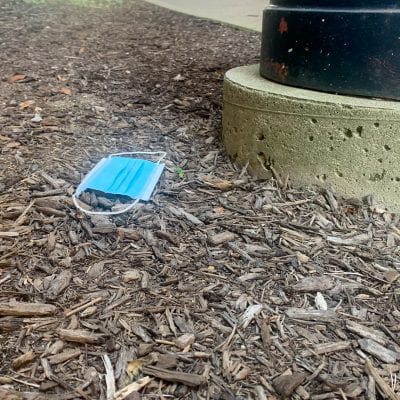
An estimated 129 billion face masks have been used globally each month during the pandemic and they are now joining the rest of the litter on the streets. Credit: Asia Atuah | Copy Chief
Crushed plastic bottles, strewn wrappers and crumpled Grubhub receipts around campus are joined by a new environmental disaster waiting to happen: littered masks.
According to a 2020 report by advocacy group OceansAsia, an estimated 52 billion disposable masks were produced last year. An estimated 129 billion face masks have been used globally each month during the pandemic, according to an article in the scientific journal Environmental Science and Technology.
Widespread mask use is expected to continue as the Centers for Disease Control and Prevention recommends universal masking indoors, regardless of vaccination status, in areas of substantial or high COVID-19 transmission — including Franklin County.
Kent Halloran, a stormwater engineer in Environmental Health and Safety at Ohio State, said in an email mask litter has exacerbated the issue of general litter on campus and in the environment.
Mask litter has appeared across campus, including building entrances, parking lots and bus stops, Halloran said. While new to the scene, he said there has been a greater increase in mask-related litter compared to other discarded materials.
Halloran said this increase is likely due to the abrupt introduction of masks on campus at large due to the pandemic, a general unawareness of the importance of recycling and reducing mask litter — like there is with other forms of litter — and a natural tendency to remove masks when they are not required, like outside, but disposing of them improperly.
“While masks were in use in medical settings prior to the pandemic, they were not commonplace in public settings as they are now,” Halloran said.
Ryan Clevenger, a fourth-year in sustainable plant systems and co-president of the Campus Cleanup Club, a group that works to clean up litter on and around campus, said masks are one of the most common types of litter the club has seen since the pandemic began.
“Masks are littered often enough that we even play a little game where we keep count of how many masks we pick up in each meeting,” Clevenger said. “It’s like a competition to see who can get the most.”
Dr. Joseph Gastaldo, system medical director of infectious diseases at OhioHealth, said virus viability on masks depends on how long the mask has been sitting, the viral load of the person who was wearing it and environmental factors such as ultraviolet light from the sun, which destroys the virus.
Gastaldo said there is no concern of COVID-19 spreading through littered masks into the surrounding area, as the virus doesn’t spread that way.
“Having masks out as discarded litter have never been proven to contribute to any spreading of COVID-19,” Gastaldo said. “But in the setting of picking up litter, if you’re going to pick up a lot of litter, you don’t know, a mask that you see on the ground, you don’t know how long it’s been there. You don’t know who wore it. You don’t really know the potential conditions of that mask being there. So, in that regard, it would be safe to consider masks as what I would call a potential biohazard out in public.”
Gastaldo said picking up littered masks is like picking up any other litter and can generally be considered safe. The safest way to do so is by using gloves and sanitizing or washing your hands before touching anything else.
Halloran said the detriments of improperly disposed masks is similar to general litter and trash, which includes negative effects on natural habitats and chemical and biological impacts.
“Masks are manufactured from non-woven fabrics made from plastics like polypropylene which help filter and protect us,” Halloran said. “But in the environment, we would expect these materials to degrade and cause the same issues as other plastic litter.”
According to the Environmental Protection Agency, plastic trash can negatively alter and degrade habitats, as well as disrupt ecosystems. Contaminants can also accumulate on the surface of plastic, potentially harming organisms that interact with the trash. Ingestion of plastics by mammals can also largely impact their bodily functions.
Halloran said the university has run various campaigns to communicate the proper way to dispose of masks safely through electronic communications, bus advertisements and newsletters. The best practice for the campus community is simply discarding general use masks in the trash, rather than out in the environment, he said.
“Mask litter has certainly become an issue everywhere during the pandemic, but it is certainly an issue that we as Buckeyes can solve by simply throwing our masks in the trash,” Halloran said.
Clevenger said having more places to properly dispose of masks can also help with the issue of mask litter, as the city lacks many public trash cans for students to throw away their used masks.
“I find mask litter really frustrating. I fully support wearing masks to keep our community safe, but I feel that the current waste management infrastructure around campus has failed to account for this new source of trash,” Clevenger said. “It’s a solvable issue, as is littering in general.”






